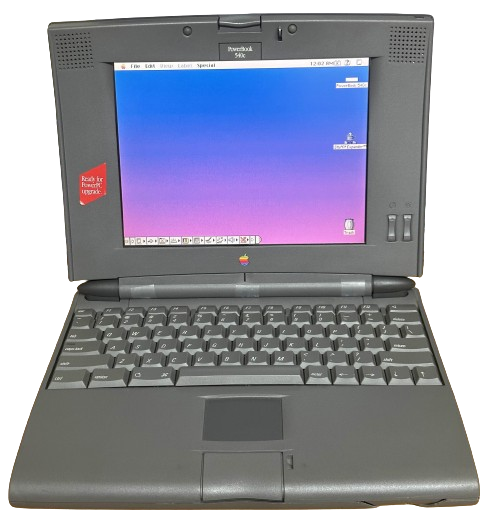
PowerBook 540c
The PowerBook 540c was the top-end model of the 500 Series in all markets except Japan, which got the higher-end 550c in 1995.
Specifications
| Spec | Details |
|---|---|
| Release Date | May 1994 |
| Discontinuation Date | August 1995 |
| Processor | Motorola 68LC040 @33MHz |
| Bus Speed | 33MHz |
| RAM | PowerBook 5xx Proprietary - 4MB soldered - 36MB Maximum |
| Hard Disk | 2.5" 40-pin SCSI - 240-500MB Standard |
| Display | 9.5" TFT/Active Matrix Color LCD @640x480 |
| GPU | Chips & Technologies 65220 (Apple CSC) - 512KB VRAM |
| Main Battery | NiMH Smart Battery - Panasonic or Sanyo AA cells |
| PRAM Battery | Lithium rechargeable |
| Power Supply | Proprietary 4-pin - 2x Voltage Rails (16V 1.5A, 16V 1.0A) - Apple P/N M1893 |
| Disk Drives | 3.5" 1.44MB Floppy Drive |
| PC Cards | Optional PCMCIA module installed in the left battery bay adds two slots. |
| Networking | - Modem - AAUI Ethernet |
| Other I/O | - 1x Serial - 1x ADB - 1x HDI-30 SCSI - 1x Mini-15 Video Out - 1x Line Out - 1x Mic In |
| Pointing Device | Trackpad |
| Minimum Mac OS | System Software 7.1.1 |
| Maximum Mac OS | Mac OS 8.1 |
Upgrades
SSD Upgrade
See our page on SCSI SSDs for more info.
Resources
 Service Manual |
Capacitor Reference (Laptop) | Capacitor Reference (Power Supply) | 3D Print Templates |
|---|
Common Faults & Maintenance
Capacitor Failure
The PowerBook 540c has a single surface mount cap in the battery charge circuit, it should be removed at the very least, and replaced if you need battery charge function. It is a 100uf 25v cap. The 540c used three different LCD manufacturers, Toshiba, Sharp, and Hosiden (rarely). The Toshiba and Hosiden panels are solid-state, but the Sharp panel has a bunch of caps on it that need to be replaced. Check which one yours is and replace if necessary.
There is also a single electrolytic through-hole cap on the inverter board.
Brittle Plastic
The whole PowerBook 500 series suffers from very brittle plastic. It's literally turning to dust!
The main issue that arrises out of this on the 500 series is hinge cracking. The hinge design on the 500 series was not built to hold up under brittle plastic, as the hinges are screwed into standoffs on the top panel of the display. These standoffs crumble away, and the hinge seperates from the case, causing a whole myriad or problems. Most importantly though, this puts your display cable at risk of damage. You can 3D print new standoffs and superglue them in place of the old ones as a relatively easy fix, so it isn't the end of the world if yours are broken. You can also reinforce the original standoffs with a bunch of epoxy if they're still intact. If they've already broken though, I'd recommend the 3D printing route.
The front cover bezel at the bottom of the display housing is also prone to having its clips snap due to stress. New clips can be 3D printed, so again, not the end of the world if yours break.
Hard Drive Failure
The 500 series PowerBooks are some of the last ones to use SCSI hard drives. These drives are a real pain in the rear, because many of them suffer from the dreaded rubber bumper problem. Basically, the head mechanism in Quantum-made hard drives of the time have little rubber bumpers that are used as stoppers for the drive heads. These bumpers turn to goo, and well, the heads just get stuck. When this happens, you might hear a quiet ticking sound from the drive as it attempts to move the heads and fails. You may be able to manually dislodge the heads, but the issue comes back again the next time you start the drive. The only way to fix this is to tape over or replace these bumpers to stop the heads from getting them stuck. Some drives have the bumpers inside the voice coil assembly, but a select few Quantums have them UNDERNEATH THE PLATTERS. Such drives are virtually unrepairable.
The easiest (but most expensive) fix to this issue would be to replace the spinning rust in your PowerBook with a ZuluSCSI, BlueSCSI, or similar. These devices were designed just for your PowerBook, and they will be a lot more reliable (and faster) than a hard drive.
Battery Leaks
The PowerBook 500 series laptops use Nickel-Metal Hydride batteries as their main power source. Besides nearly all of them being dead today, they have a nasty tendancy to leak their guts all over the inside of your PowerBook. These laptops can have either one or two batteries, and if dead, you should check to make sure they aren't leaking. Even if they aren't leaking, NEVER leave them in for a long time, working or dead. If they are leaking, get them out and leave them out until you crack them open and remove/replace the bad cells!
The PRAM batteries in these PowerBooks are not known to leak commonly, but it's never a bad idea to remove them anyway as the PowerBook will run fine without them.
Gallery
Coming soon.
Page last updated (MM/DD/YYYY): 08/14/2024
Update Reason: page rewritten
Back-Navigation
Index < Macintosh Portal < PowerBook Home < PowerBook 540c